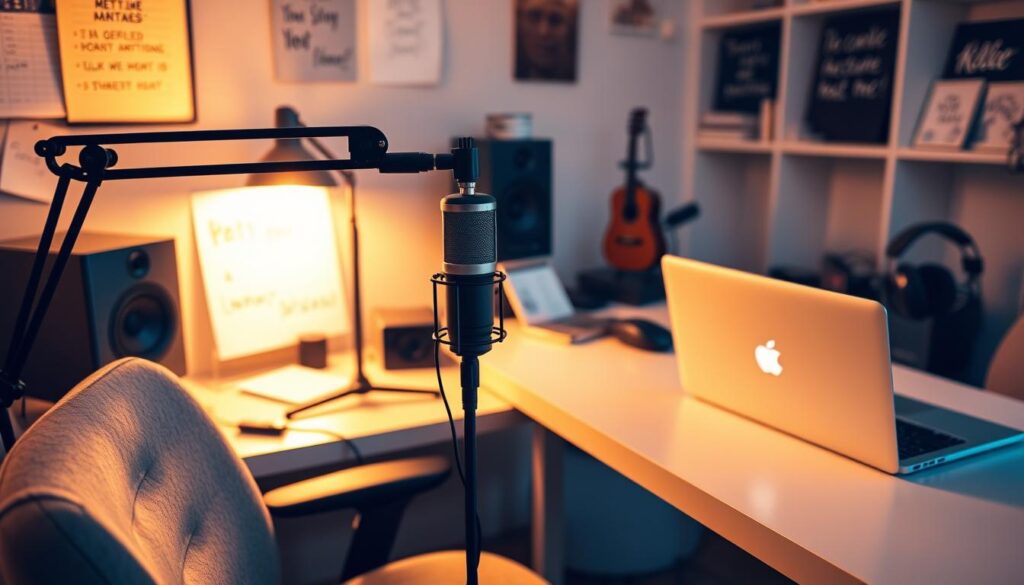Ready to dive into the world of audio storytelling? Starting a podcast can be an exciting journey, but it requires careful planning and execution. As Oprah Winfrey once said, “The greatest discovery of all time is that a person can change their future by merely changing their attitude.” This mindset is crucial for aspiring podcasters looking to make an impact.
This comprehensive guide, inspired by Buzzsprout’s expertise in helping over 300,000 podcasters, offers a 10-step framework to launch and grow your podcast. From choosing the right equipment to crafting compelling content, we’ll cover it all. Whether you’re a seasoned creator or just beginning, this guide will walk you through every step, ensuring your podcast resonates with listeners.
Your podcast’s success hinges on consistency, quality, and engagement. With the right strategies, you can build a loyal audience and stand out in this booming industry. So, take the first step today and turn your audio vision into reality!
Key Takeaways
- Plan your podcast’s concept and format carefully.
- Invest in quality equipment and software.
- Develop a consistent publishing schedule.
- Design eye-catching artwork to attract listeners.
- Engage your audience with compelling content.
Crafting Your Podcast Vision
Creating a compelling podcast begins with a clear vision. Defining your niche and goals is the first step in building a loyal audience. Your podcast’s niche should be specific enough to stand out but broad enough to attract a sizable audience. Consider what unique perspective or expertise you bring to the table. Whether it’s storytelling, education, or entertainment, your niche should reflect your passion and expertise.
Your goals should be clear and achievable. Are you aiming to educate, entertain, or inspire? Understanding your purpose will guide every aspect of your podcast, from content creation to audience engagement. Successful podcasters like [Example] have thrived by staying true to their vision and adapting to their audience’s needs.
Setting a clear brand identity is equally important. Your podcast’s title, description, and artwork should instantly convey its essence. Use descriptive language in your title and description to attract your target audience. Consistency in your brand’s voice and messaging will help build trust and recognition. Remember, your podcast is more than just audio; it’s a representation of your brand’s values and personality.
Developing Your Podcast Concept
Building a strong podcast concept is the backbone of your show’s success. It’s all about creating a clear vision that resonates with your audience. Start by brainstorming episode ideas that align with your podcast’s niche. Consider what your listeners might find engaging and informative. Whether it’s storytelling, interviews, or educational content, your episodes should offer value to your audience.
Brainstorming Episode Ideas
A great way to generate ideas is by using mind mapping or asking your target audience directly. Listener surveys can provide insights into their interests. For example, if you’re creating a podcast about health, ask your audience about their biggest challenges. This ensures your content stays relevant and engaging. Additionally, planning ahead by creating a list of 25 episode ideas can help you stay consistent and avoid writer’s block.
Conducting Market Research

Understanding your competition is crucial. Analyze top podcasts in your niche on platforms like Apple Podcasts. Identify gaps in their content and fill them with your unique perspective. Use reliable resources like Buzzsprout’s guides to stay updated on market trends. This research will help you refine your concept and make it stand out in a crowded space.
By balancing creativity with practical steps, you can develop a sustainable podcast concept. Remember, your podcast is more than just audio—it’s a connection with your audience. Stay focused, and with the right approach, your podcast will thrive.
Choosing Your Podcast Format and Style
When it comes to creating a podcast, one of the most important decisions you’ll make is choosing the right format and style. This decision will shape how your audience engages with your content and can significantly impact the production process. Whether you’re leaning toward a solo show, a co-hosted format, or an interview-style podcast, each option has its pros and cons.
Evaluating Solo, Co-hosted, and Interview Options
A solo podcast allows for a more personal connection with your audience, offering a straightforward approach to recording and editing. On the other hand, co-hosted podcasts bring dynamic interactions and diverse perspectives, which can be highly engaging. Interview-style podcasts are great for offering expert insights and varied viewpoints, making them particularly popular among listeners.
Determining Optimal Episode Length
The length of your episodes is another crucial factor. Research suggests that episodes between 20 to 60 minutes tend to perform well, as they strike a balance between concise content and in-depth discussions. Consider your audience’s preferences and the complexity of your topics when deciding on the ideal length for your episodes.
Ultimately, the format and style you choose should align with your goals and the value you aim to deliver. Experimenting with different formats in your early episodes can help you find what resonates best with your audience. Remember, the key to success lies in consistency and delivering high-quality audio that keeps your listeners coming back for more.
Podcasting Equipment Essentials
Investing in the right equipment is crucial for producing high-quality audio. Whether you’re just starting out or upgrading your setup, choosing the right tools can make a significant difference in your podcast’s sound.
Selecting the Right Microphone
The microphone is the heart of your podcasting setup. Dynamic microphones, like the Samsung Q2U, are great for capturing clear vocals and handling high sound pressure levels, making them ideal for lively discussions. On the other hand, condenser microphones, such as the Shure MV7, offer superior sound detail and are often used in professional studios. Each type has its pros and cons, so it’s important to choose one that fits your recording environment and style.
Essential Accessories for Better Audio
Don’t overlook the importance of accessories in enhancing your audio quality. A good pair of headphones, like the Beyerdynamic DT 700 Pro X, helps you monitor your recordings in real-time. Pop filters and boom arms are also must-haves to reduce plosive sounds and allow for flexible mic placement. These small investments can significantly improve your overall sound without breaking the bank.
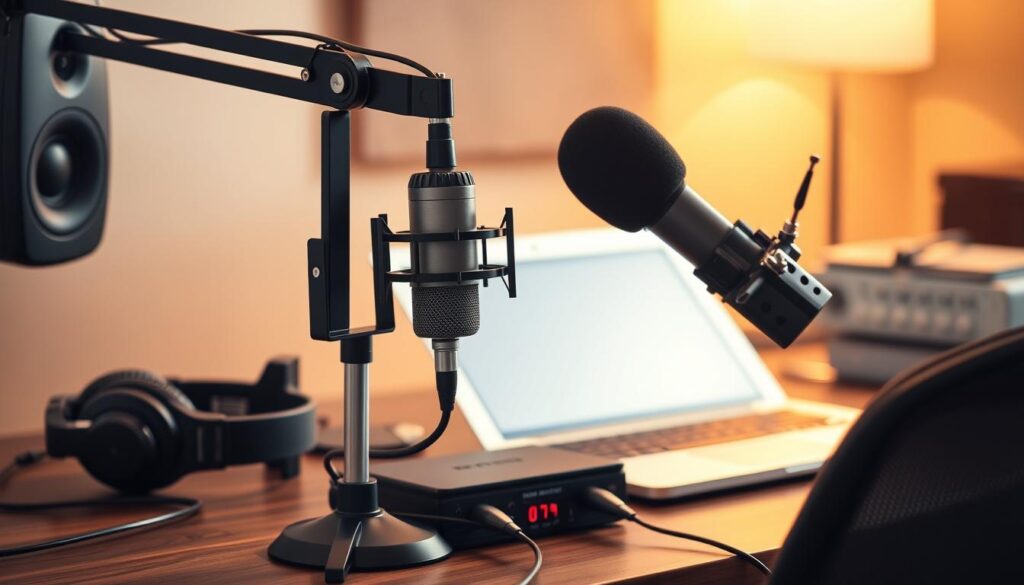
By selecting the right microphone and accessories, you can achieve professional-grade audio that captivates your audience. Remember, quality equipment is an investment in the success of your podcast.
Selecting the Right Podcast Software
When it comes to creating a podcast, the right software can make all the difference. Whether you’re recording, editing, or managing your episodes, choosing the right tools is essential for producing high-quality audio. In this section, we’ll explore the best software options available and how to select the one that fits your needs.
Exploring Editing Tools and Remote Recording Options
There are several types of software you can use for podcasting, ranging from free to paid options. Audacity and GarageBand are popular choices for those just starting out, offering user-friendly interfaces and basic editing features. For more advanced users, Descript and Adobe Audition provide professional-grade tools for editing and enhancing your audio.
Remote recording has become increasingly popular, especially for interviews or co-hosted podcasts. Tools like Zoom and Riverside.fm allow you to record high-quality audio with guests from anywhere in the world. These platforms often come with additional features like separate audio tracks for each participant, making the editing process much smoother.
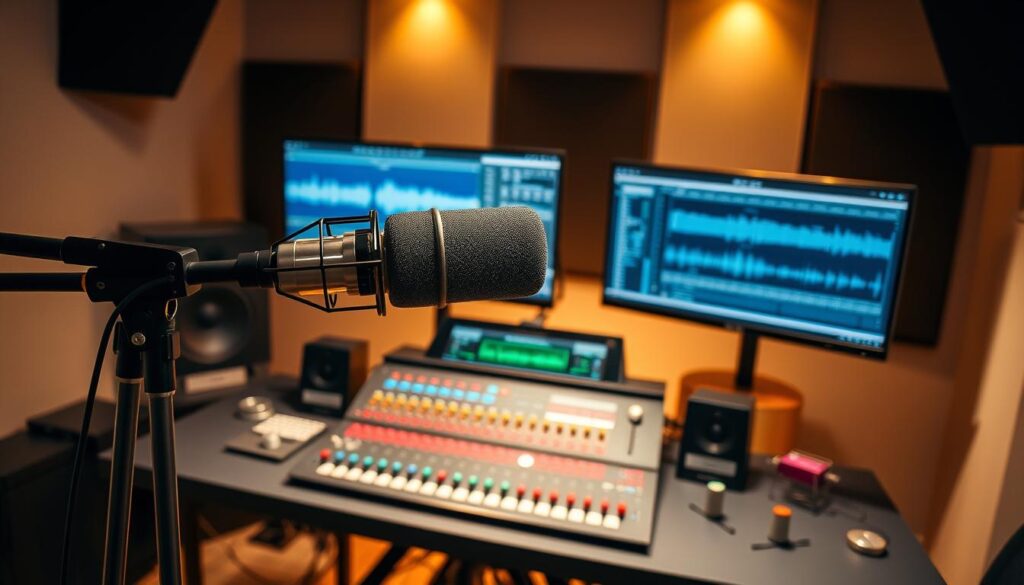
When choosing software, consider your technical skill level, budget, and the specific features you need. For example, if you’re looking for an all-in-one solution, Alitu is a great option that handles recording, editing, and even publishing your podcast. On the other hand, if you’re on a tight budget, Audacity is a free and powerful tool that can meet most of your podcasting needs.
By selecting the right software, you can streamline your podcast production process and ensure your episodes sound professional and engaging. Remember, the key is to find a tool that fits your workflow and helps you achieve your podcasting goals.
Setting Up Your Recording Space
Creating a professional-sounding podcast starts with a well-optimized recording space. A dedicated, quiet area is essential to minimize background noise and ensure high-quality audio. Even a small closet can become a makeshift studio—its natural sound-absorbing qualities make it ideal for recording.
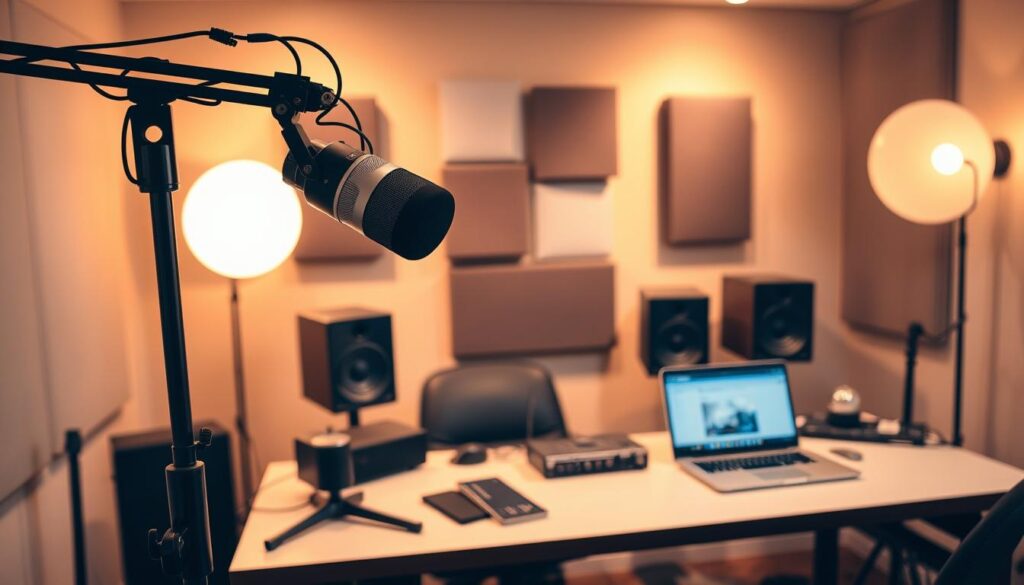
To arrange your equipment effectively, place your microphone at least 6-8 inches away from any walls to reduce echo. Use a microphone stand or boom arm for flexibility, and position it slightly above your mouth to capture your voice clearly. For budget-friendly soundproofing, hang thick blankets or pillows on walls to absorb sound reflections.
Optimizing your space doesn’t have to break the bank. DIY solutions like placing rugs on bare floors and using household items as makeshift diffusers can significantly improve acoustics. Remember, your recording environment is as important as your equipment—it directly impacts how your audience experiences your show.
Recording Your First Episode
Recording your first episode is an exciting milestone in your podcasting journey. It’s where your planning and preparation come to life, and your vision transforms into audio reality. This step is crucial as it sets the tone for your entire show, so it’s important to approach it with careful attention to detail.
Creating a Structured Outline
A well-structured outline is the backbone of a successful recording session. Start by breaking down your episode into clear segments, such as an introduction, main content, and outro. Dedicate specific minutes to each segment to maintain a cohesive flow. For example, allocate 5 minutes to your intro, 30 minutes to the main discussion, and 5 minutes for the outro. This structure will help you stay focused and ensure your episode remains engaging from start to finish.
When scripting your outline, consider your audience’s preferences. Personal stories and clear explanations can make your content more relatable and engaging. Remember, your goal is to provide value while keeping your listeners interested. A structured approach will also help you avoid rambling and stay on topic.

Testing and Adjusting Microphone Techniques
Before hitting record, it’s essential to test your microphone placement and audio levels. Proper microphone technique can make a significant difference in sound quality. Aim to maintain a consistent distance from the mic to avoid volume fluctuations. Test for plosives by saying words with strong consonants and adjust your pop filter as needed. Record a test track to ensure your audio levels are within the optimal range of -18dB to -20dB.
Once you’re satisfied with your setup, it’s time to start recording. Begin with a strong opening that grabs attention, whether it’s a catchy intro music or a compelling hook. As you progress through your outline, remember to speak clearly and at a moderate pace. Don’t rush, but also avoid dragging out points. Keep your energy levels consistent to maintain listener engagement.
Time Management and Test Tracks
Managing your time effectively is key to a smooth recording process. Stick to your outlined structure and allocate specific minutes to each segment. If you find yourself going off track, gently guide the conversation back to your main points. After recording, listen to your test tracks to identify areas for improvement. Pay attention to audio quality, pacing, and overall flow.
By following these steps, you’ll be well-prepared to record a high-quality first episode. Remember, consistency and clarity are key to keeping your audience engaged. Take a deep breath, stay focused, and let your passion shine through in your recording. Your audience is ready to hear what you have to say!
Editing and Enhancing Your Audio
Transforming raw recordings into polished episodes is where the magic happens. Editing is crucial for delivering professional-sounding audio that captivates your audience.
Utilizing Editing Software Effectively
Start by choosing the right tools. Audacity and Adobe Audition are popular choices, each offering unique features. Use these tools to trim silence, adjust volume levels, and seamlessly blend intro/outro music. For instance, fading transitions can create a smooth listening experience.
Optimizing Sound Quality with Practical Tips
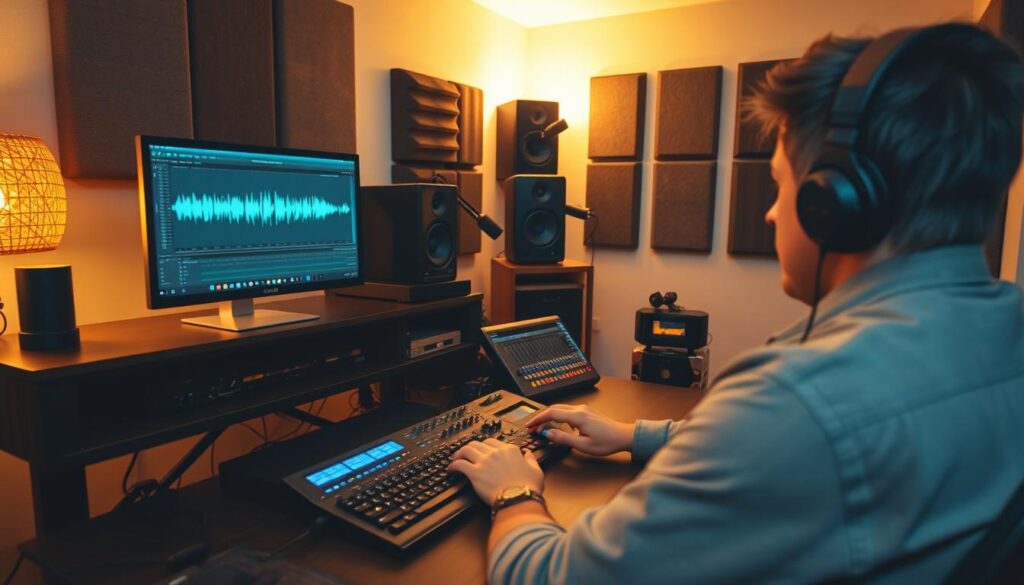
First, remove background noise using noise reduction tools. Next, balance your audio levels to ensure consistency. Consider using compression to even out volume fluctuations. Finally, export your file in the correct format for hosting, typically MP3.
- Use noise reduction tools to clean up your audio.
- Balance volume levels for a consistent listening experience.
- Export files in MP3 format for distribution.
By following these steps, you’ll create high-quality audio that keeps your audience engaged and coming back for more.
Designing Eye-Catching Podcast Artwork
Creating captivating podcast artwork is essential for grabbing attention in a crowded market. A well-designed cover art can make your podcast stand out and attract potential listeners. Let’s explore how to craft artwork that meets directory standards and resonates with your audience.
Understanding Artwork Specifications
Podcast platforms like Apple Podcasts require specific dimensions for artwork. The ideal size is a square image of 3000 x 3000 pixels with RGB colors in PNG or JPEG format. This ensures your artwork looks sharp and professional across all devices. High-resolution images are crucial to prevent pixelation, especially on high-definition screens.
When designing, remember that your artwork will be viewed in various sizes, from small thumbnails on mobile devices to larger images on desktops. Use contrasting colors to enhance visibility and ensure your design is clear and engaging. Avoid clutter and keep text minimal—ideally no more than seven words—to maintain legibility.
Creating Visually Appealing Cover Art
Your podcast artwork should reflect the essence of your show. Incorporate elements that represent your podcast’s theme, whether it’s through imagery, symbols, or colors. For example, a true crime podcast might use dark tones and bold fonts to convey mystery and intrigue.
Consider your podcast title and brand identity. Ensure the title is prominently displayed and easy to read. Your artwork should be a visual representation of your podcast’s brand, making it instantly recognizable to your audience. For inspiration, look at successful podcasts and analyze what makes their artwork effective.
Cost-Effective Design Solutions
Creating professional artwork doesn’t have to break the bank. You can hire a designer on platforms like Fiverr starting at $5 or use design services like Canva for free. These tools offer templates and features that help you create stunning artwork without extensive design experience.
Investing in quality artwork is worth it. Remember, your cover art is often the first impression potential listeners have of your podcast. It reflects the overall quality of your show and can be a deciding factor in whether someone chooses to listen.
By following these guidelines, you can create artwork that not only meets technical requirements but also captures the essence of your podcast. Make your artwork a compelling invitation that draws listeners in and keeps them engaged.
Learn moreabout creating visually appealing designs that attract attention.
Publishing Strategies and Podcast Hosting
Now that your podcast is recorded and edited, it’s time to share it with the world. Publishing your podcast involves a few key steps that ensure your episodes reach your target audience seamlessly. This process starts with choosing the right hosting service and submitting your podcast to major directories like Apple Podcasts and Spotify.
Submitting to Major Podcast Directories
To get your podcast discovered, you need to list it in popular directories. Apple Podcasts is one of the largest platforms, and getting your podcast approved there can significantly boost your visibility. The process typically takes between 24 hours to two weeks, so plan accordingly. Ensure your podcast meets their requirements, including proper metadata and artwork dimensions of 3000 x 3000 pixels.
Preparing Your Audio File
Your audio file should be in a compatible format like MP3 or WAV, with a recommended bitrate of 96 kbps for optimal quality and faster downloads. Keep your file size under 200MB to avoid issues during upload. Use tools like Audacity to make final adjustments and ensure your audio is clear and well-formatted.
Writing an Engaging Podcast Description
Your podcast description is your first impression. Make it count by crafting a compelling summary that highlights your show’s unique value. Include relevant keywords your audience might search for, but keep it natural and engaging. Avoid clutter and focus on what makes your podcast stand out.

Consistent Publishing and Organization
Consistency is key to keeping your audience engaged. Decide on a publishing schedule—whether weekly, biweekly, or monthly—and stick to it. Organize your episodes clearly, making it easy for listeners to find and follow your content. A well-structured approach helps build loyalty and keeps your audience coming back for more.
By following these steps, you can ensure your podcast is widely available, attract new listeners, and maintain a loyal audience. Take the final leap and share your podcast with the world today!
Promoting Your Podcast on Social Media
Ready to amplify your podcast’s reach? Social media is a powerful tool for connecting with your audience and growing your listener base. By leveraging visual soundbites and engaging content, you can make your podcast stand out in a crowded space.
Leveraging Visual Soundbites and Social Tools
Eye-catching visual soundbites are a game-changer for social media promotion. These short, engaging clips highlight key moments from your episodes. Platforms like Instagram Reels and TikTok are ideal for sharing these bite-sized videos, which can range from 30 to 60 seconds. For example, Instagram Reels can be up to 15 minutes long, offering flexibility for more detailed content. Use tools like Descript to create these soundbites effortlessly.

Engaging Your Target Audience
Consistency is key to keeping your audience engaged. Regular posts and interactive content, such as polls or Q&A sessions, encourage listener participation. Integrating social media calls-to-action with each podcast release directs listeners to platforms like Apple Podcasts. Real-time engagement on Twitter and Facebook can drive more downloads, as listeners feel connected to the conversation.
- Share behind-the-scenes content to build a personal connection with your audience.
- Use trending topics to increase visibility and engagement.
- Engage with your audience through comments and messages to foster loyalty.
By combining these strategies, you can effectively promote your podcast on social media, expand your reach, and build a loyal audience. Remember, consistency and creativity are your best allies in this dynamic space.
Effective Podcasting Strategies for Success
To elevate your podcast and attract a loyal audience, consider implementing advanced strategies that go beyond the basics. These tactics can help you grow your listener base and keep them engaged over time.
Implementing Advanced Marketing Tactics
A powerful way to expand your reach is through strategic guest interviews and business partnerships. Inviting experts or influencers as guests can add credibility and attract their followers to your show. For example, a well-structured interview with a thought leader can provide valuable insights and draw new listeners. Additionally, collaborating with businesses can open doors for sponsorships or cross-promotions, further boosting your podcast’s visibility.

Using marketing tools like social media management platforms can also enhance your promotion efforts. Sharing engaging content, such as video clips or quotes from your episodes, can attract new listeners. Consistency is key—regularly posting updates and interacting with your audience can significantly increase your podcast’s visibility each week.
Learning from Industry Best Practices
Continuous learning is essential for keeping your content fresh and relevant. Enrolling in courses or attending workshops can help you stay updated on the latest trends and tools. For instance, learning about audio editing techniques or understanding your audience’s preferences through analytics can make a big difference in the quality of your episodes.
Listening to feedback from your audience is another crucial aspect. By understanding what resonates with your listeners, you can tailor your content to meet their needs better. Many successful podcasters attribute their growth to adaptability and a willingness to evolve based on listener input.
By combining these strategies, you can create a podcast that not only grows in popularity but also builds a lasting connection with your audience. Remember, success in podcasting is a journey that requires dedication, creativity, and a commitment to continuous improvement.
Taking the Final Leap: Launch Your Podcast Today!
Starting a podcast might feel daunting, but with the right preparation, it’s a journey worth taking. Many podcasters, like those featured in the School of Podcasting, have turned their passion into a successful show. Remember, every podcast begins with a single step.
Your podcast’s success hinges on consistency, quality, and engagement. With the right strategies, you can build a loyal audience and stand out in this booming industry. So, take the first step today and turn your audio vision into reality!
Recording your first episode is an exciting milestone in your podcasting journey. It’s where your planning and preparation come to life, and your vision transforms into audio reality. This step is crucial as it sets the tone for your entire show, so it’s important to approach it with careful attention to detail.
By following these steps, you’ll be well-prepared to record a high-quality first episode. Remember, consistency and clarity are key to keeping your audience engaged. Take a deep breath, stay focused, and let your passion shine through in your recording. Your audience is ready to hear what you have to say!

